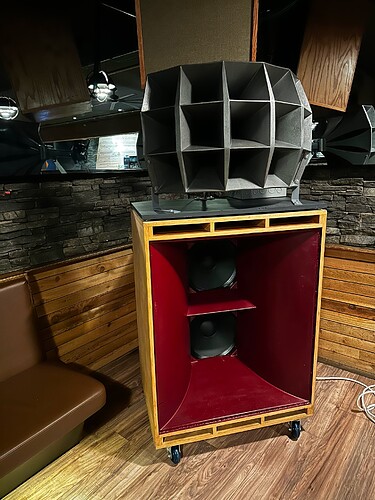This week we installed our first dual woofer Cafe Sound “High Output” speakers at Shibuya HiFi in Seattle.
I want to discuss the history and design considerations for these speakers.
First, let me back up by saying that I started Cathode Bias the company with the intention of building sound systems specifically for commercial spaces and the listening bar market.
The reality is, I’ve come away disappointed with many systems I’ve seen installed in listening rooms and HiFi bars in the US. The Cafe Sound speakers were built to scratch the itch of creating a good audio experience in large and active rooms while maintaining a vintage aesthetic.
One common problem I see is inappropriate speakers being installed into large rooms – for instance speakers designed for monitoring. Consider the Altec 604 (which is one of my favorite speakers for HiFi listening). The 604 is a coaxial driver with a 15" woofer and a small horn. The horn is often crossed over over around 1500hz, which requires the woofer to cover a significant amount of the midrange. Because of the physics of larger drivers, this causes the speakers to be fairly directional. Generally this is ok in a smaller room, like a control room, or home listening room, but in a large commercial space, most people will not be on-axis and therefore have a severely impeded experience.
Secondly, monitor speakers often don’t have the SPL output required in large and active rooms which when combined with their poor off-axis performance requires the output to be increased the point of being overdriven. This can particularly problematic depending on the programming (for instance HipHop, House, or electronic)
Traditional multi-cellular horn systems by makers like JBL, Jensen, and Altec Lansing provide a traditional solution to the problem of filling a larger room by combining high efficiency with a large dispersion area. Also these systems can maintain the vintage aesthetic that operators are looking for in their rooms.
In a perfect scenario all frequencies would come from a single point in the horn, but the physical constraints of building a horn that handle all audible frequencies, generally make such a design impractical. Instead smaller horns are used which generally constrains the usable frequency bandwidth of the horn.
Below the usable frequencies of the horn, direct radiating woofers are typically used to augment the horn, and in modern implementations tweeters or “super tweeters” are often added to handle frequencies above the usable range of the horn. Generally 3 way systems are becoming the standard.
The difficult part of traditional horn implementations is blending the woofers with the horn mid-range and tweeters. It isn’t uncommon for the woofers to crossover as high as 800hz, well into the lower midrange. This results in some compromises, including difficulty in tuning the woofers to provide both extended bass and mid-range clarity.
Recently new components and horn drivers, have become available which change the design constraints for horn speakers. Specifically high-bandwidth coaxial compression drivers. By combining low frequency and high frequency drivers into one, it is possible to remove the need for a separate tweeter while allowing the horn to crossover at a lower frequency. This makes the horn act more as a single point source, and allows the woofers to perform more in the mid-bass region vs low mid-range.
The result is a system that delivery a high degree dispersion, clarity, and SPL output . We installed such a system in a 2000 sq ft commercial listening room, and still maintained significant headroom from the system, unlike many traditional HiFi systems which tend to be overdriven in larger rooms.
Overall I’m optimistic about combining old and new technology in a way which creates a system with good performance and vintage aesthetics.
